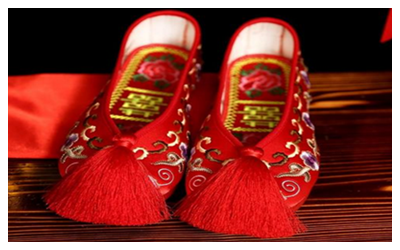- Home
- Travel In China > China Culture > Chinese Handicrafts >
Chinese embroidered shoes
Chinese-style embroidered shoes, which have been deemed as a perfect combination of the shoe culture and the art of embroidery, are a 100-percent handicraft creation by Chinese people. Deeply rooted in Chinese culture, they are reputed as "Chinese shoes".

In ancient China, ever since the matrilineal society was replaced by a patrilineal one, the social division of labor has been based on men ploughing and women weaving; the tradition of embroidering shoes has been passed down from one generation to another by Chinese women. Aesthetic conceptions, cultural traditions, ethics and morals, as well as the fashion of different dynasties, have all been well expressed by the needle and thread with which subtle and interesting changes have been incorporated.
But when and where did embroidered shoes first appear? Works that have been passed down from ancient times fail to provide us with explicit evidence. The popular tale of the "Jin Shoes" may, however, give us some inspiration.
In the Spring and Autumn and Warring States periods dating back more than 2,600 years, the Jin was headquartered in Shanxi Province . In 606 BC when Jin
Xiangong became the monarch, he set out to expand the territory, merging 10 vassal states. To immortalize his cultural and military achievements in the minds of the masses,
Jin ordered that the shoes belonging to all women in the palace should depict 10 fruit or flower patterns, including pomegranate blossoms, peach blossoms, grapes, etc. He also maintained that all civilian girls should wear the "10-fruit shoes" at their weddings so that the generations to follow would not forget his legacy. At that time, the female embroidered shoes bearing such patterns were called "
Jin shoes". From then on, the art of embroidery extended from shoes to clothing and other daily utilities.
Colorful silky threads are used to embroider elaborate patterns on the shoe from heel to toe, and from the sole to the shoe padding.
The themes for shoe embroidery originate from daily life -- such as folk culture and folk customs -- and nature, including flowers and grass, birds and beasts, and theatrical figures.
The seemingly traditional embroidered shoes fall into different types: trendy, indoor and traditional. The most attractive aspect of embroidered shoes is their soft texture and comfort. As a result, embroidered shoes are back in vogue, especially among young people. The perfect combination of the fashion and tradition produce a truly unique product.
Many young people believe embroidered shoes add a touch of elegance to the modern woman without looking too conservative. And more than 20 ethnic groups still wear embroidered shoes as part of their characteristic dress. Embroidered shoes have become more than footwear these days -- they are one of the Chinese cultural treasures.

 In ancient China, ever since the matrilineal society was replaced by a patrilineal one, the social division of labor has been based on men ploughing and women weaving; the tradition of embroidering shoes has been passed down from one generation to another by Chinese women. Aesthetic conceptions, cultural traditions, ethics and morals, as well as the fashion of different dynasties, have all been well expressed by the needle and thread with which subtle and interesting changes have been incorporated.
In ancient China, ever since the matrilineal society was replaced by a patrilineal one, the social division of labor has been based on men ploughing and women weaving; the tradition of embroidering shoes has been passed down from one generation to another by Chinese women. Aesthetic conceptions, cultural traditions, ethics and morals, as well as the fashion of different dynasties, have all been well expressed by the needle and thread with which subtle and interesting changes have been incorporated. Ask Questions ?
Ask Questions ?